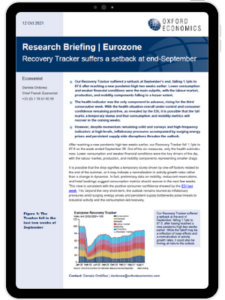Eurozone | Recovery Tracker suffers a setback at end-September

Our Recovery Tracker suffered a setback at September’s end, falling 1.1pts to
87.6 after reaching a new pandemic high two weeks earlier. Lower consumption and weaker financial conditions were the main culprits, with the labour market, production, and mobility components falling to a lesser extent.
The health indicator was the only component to advance, rising for the third
consecutive week. With the health situation overall under control and consumer confidence remaining positive, as revealed by the ESI.
What you will learn:
- Inflationary pressures accompanied by surging energy
prices and persistent supply-side disruptions threaten the outlook - Lower consumption and weaker financial conditions were the key drivers of the dip, with the labour market, production, and mobility components representing smaller drags
- It it is possible that the fall marks a temporary slump and that consumption and mobility metrics will recover in the coming weeks
Tags:
Related Services

Post
House prices continue to slide for China’s cities
Research Briefing Eurozone | Recovery Tracker suffers a setback at end-September While the property market downturn has been universal, the scale and depth has been varied for different cities and regions.
Find Out More
Post
The Construction Productivity Challenge in Australia
Delve into the state of construction productivity in Australia. Understand the factors affecting growth and how innovation can transform the industry for the better.
Find Out More